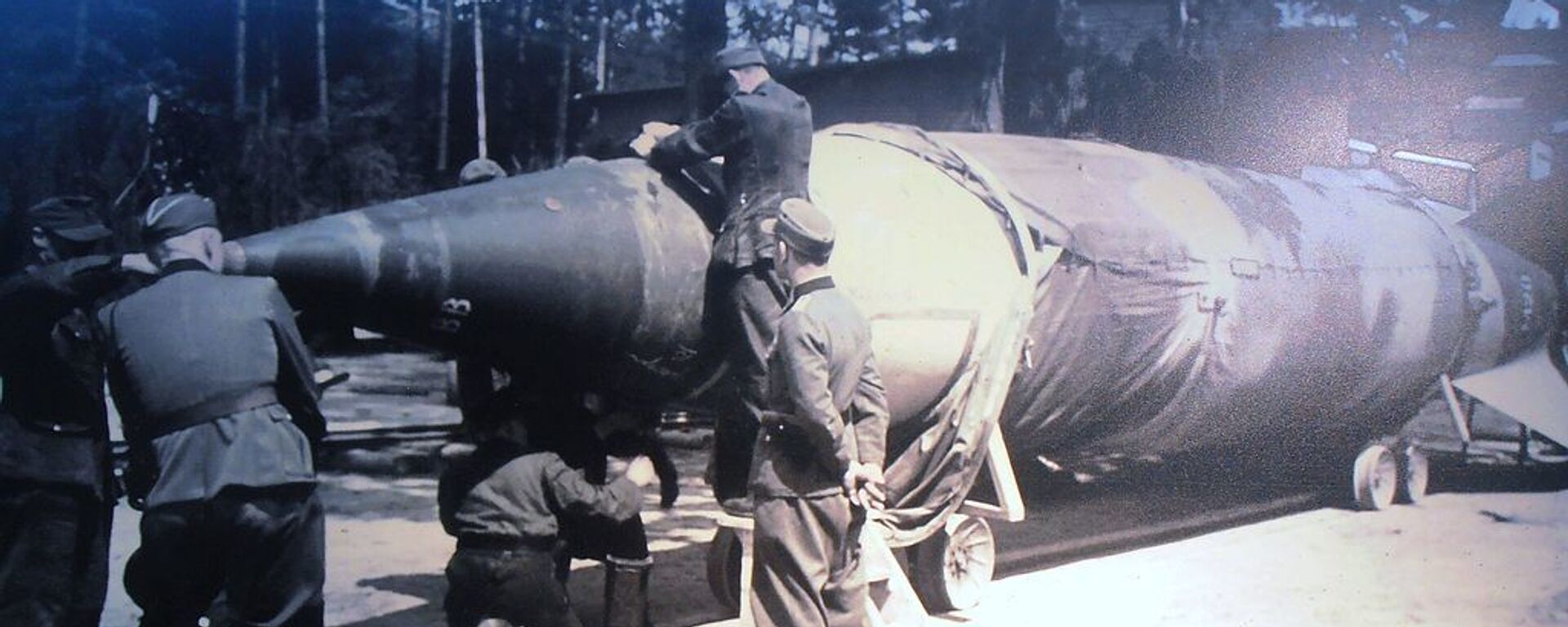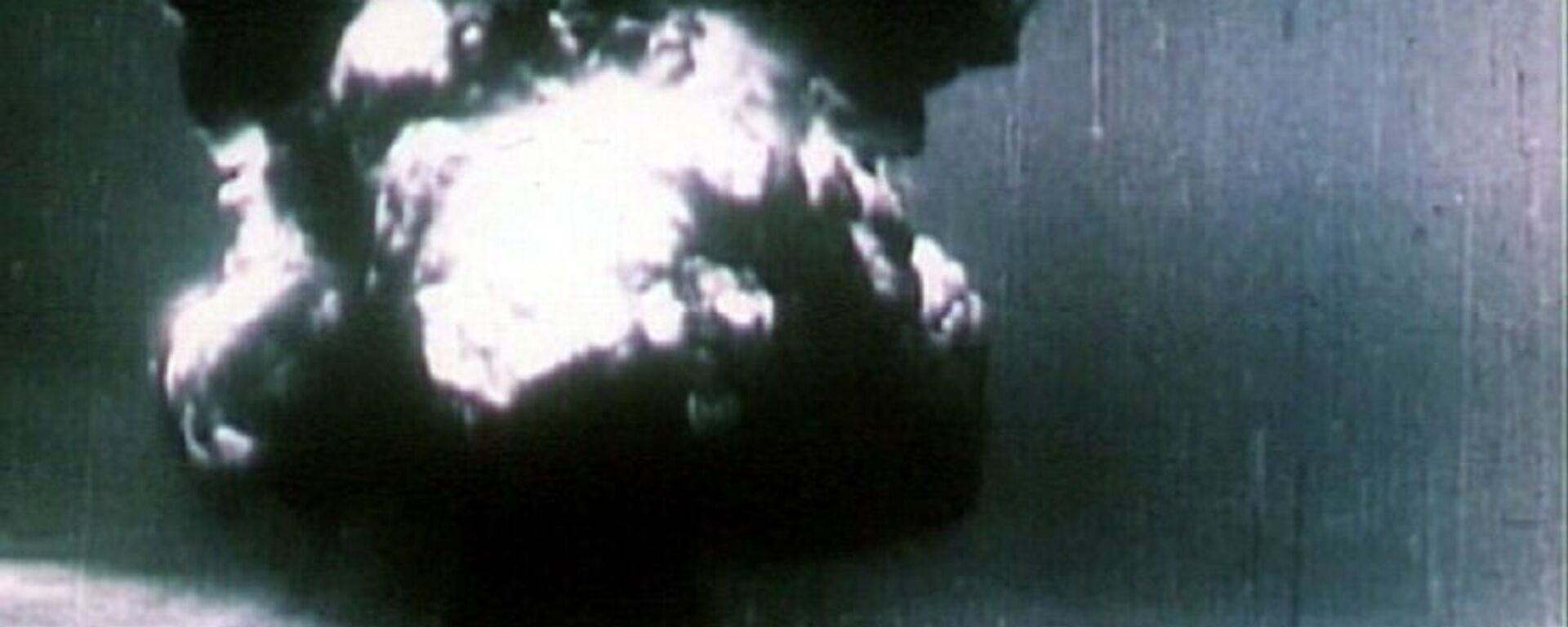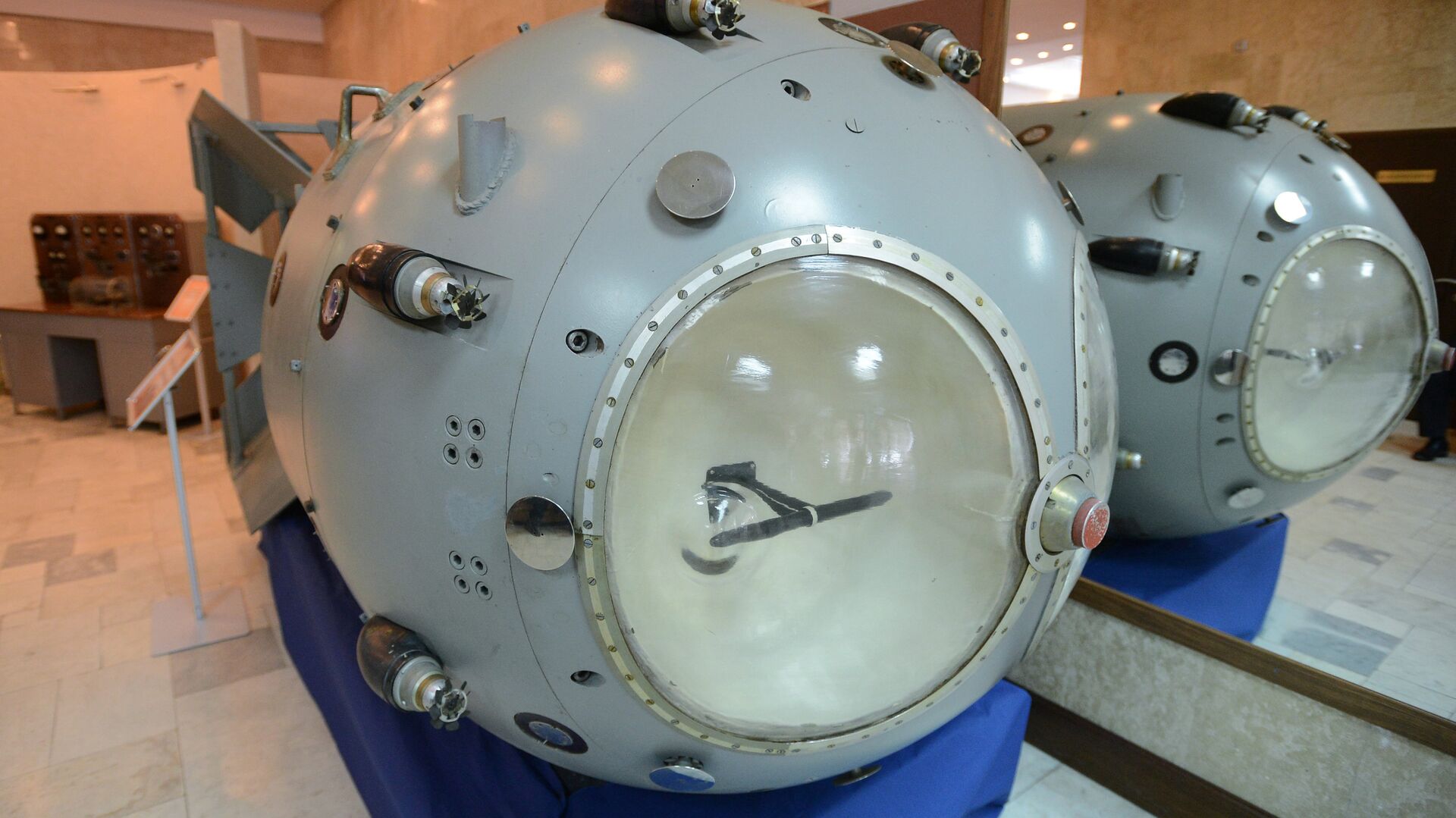https://sputnikglobe.com/20240829/august-29-1949-the-day-americas-monopoly-on-nuclear-weapons-came-to-an-end-1119949308.html
August 29, 1949: The Day America’s Monopoly on Nuclear Weapons Came to an End
August 29, 1949: The Day America’s Monopoly on Nuclear Weapons Came to an End
Sputnik International
75 years ago today, the USSR tested its first atomic weapon, becoming the second country in the world after the United States to master the fearsome... 29.08.2024, Sputnik International
2024-08-29T15:50+0000
2024-08-29T15:50+0000
2024-08-29T16:01+0000
military
joseph stalin
ussr
moscow
russia
nkvd
cia
soviet union
nuclear bomb
balance of power
https://cdn1.img.sputnikglobe.com/img/105748/72/1057487220_0:115:3235:1934_1920x0_80_0_0_a49272ae0dddc28896401c4a50ad4d35.jpg
Armed with an explosive yield equivalent to about 22 kt of TNT, the 4.7-ton RDS-1 used in the test was a combat-ready weapon designed to be dropped from a Tupolev Tu-4 strategic bomber. About 30 RDS-1s were produced by the mid-1950s after the successful August 29, 1949 test.The test ended America’s nuclear monopoly, adding much-needed balance in international politics, reining in American and European imperialism, preventing the Cold War from going hot, and ultimately, providing modern Russia with a guaranteed capability to respond to large-scale military aggression.That, Ryabеv recalled, led to the acceleration of Soviet nuclear research via the creation of a powerful Special Committee headed by NKVD chief Lavrentiy Beria in August 1945.The 1949 test surprised the CIA. Agency analysts had expected the first Soviet nuclear bomb to appear only by the early-to-mid 1950s, underestimating the USSR’s scientists, Beria’s organizational skills, and Moscow’s possession of high-grade uranium ore deposits.By the early 1940s, the USSR amassed dozens of world-class atomic scientists, from Igor Kurchatov and Yuli Khariton to Isaak Kikoin, Andrei Bochvar, Igor Tamm, and many others. The Soviet State Defense Committee approved work on what would become the Soviet nuclear program in September 1942, at the height of the Battle of Stalingrad.“We were exceptionally lucky that there was a person who…took responsibility and led us through the most difficult moments,” Ryabev recalled, referencing Kurchatov’s critical role as head of the Soviet nuclear program.While the USSR had its own independent path to a nuclear bomb, atomic espionage did give Moscow crucial information on foreign efforts in this field. The Cambridge Five, Klaus Fuchs, the Rosenbergs and many others risked their careers and lives to provide Moscow with critical information on foreign nuclear developments, from classified documents and photographs, to details on the political, diplomatic and military aspects of the US nuclear problem.That’s why when President Truman informed Joseph Stalin that the US was in possession of “a new weapon of unusual destructive force,” Stalin, to Truman’s surprise, expressed little interest, nonchalantly replying that he hoped the US would make “good use of it against the Japanese.” By that point, the Soviet nuclear program was in full swing, receiving help along the way from intelligence.Modern Russia prides itself on its great scientific minds, and doesn’t rest its Soviet laurels when it comes to new developments in experimental physics. Right now, scientists at the Sarov Nuclear Center are currently working on the UFL-2M ‘Tsar Laser’ – a 192-beam mega installation expected to become the most powerful laser in the world. The Tsar Laser will prove useful for research in high energy density and astrophysics, as well as the creation of a new generation of nuclear weapons, thanks to its ability to model processes occurring at the moment of a nuclear explosion.
https://sputnikglobe.com/20200917/arthur-adams-the-unassuming-swedish-soviet-spy-who-exposed-americas-greatest-military-secret-1080492006.html
https://sputnikglobe.com/20190829/wunderwaffe-failure-russian-scientist-explains-why-hitlers-reich-never-built-a-nuke-1076670690.html
https://sputnikglobe.com/20190829/first-soviet-nuclear-bomb-test-how-it-happened-1076671577.html
ussr
moscow
russia
soviet union
Sputnik International
feedback@sputniknews.com
+74956456601
MIA „Rossiya Segodnya“
2024
News
en_EN
Sputnik International
feedback@sputniknews.com
+74956456601
MIA „Rossiya Segodnya“
Sputnik International
feedback@sputniknews.com
+74956456601
MIA „Rossiya Segodnya“
when was us nuclear monopoly broken, who developed the second nuclear bomb, did the soviet union steal american nuclear technology
when was us nuclear monopoly broken, who developed the second nuclear bomb, did the soviet union steal american nuclear technology
August 29, 1949: The Day America’s Monopoly on Nuclear Weapons Came to an End
15:50 GMT 29.08.2024 (Updated: 16:01 GMT 29.08.2024) 75 years ago today, the USSR tested its first atomic weapon, becoming the second country in the world after the United States to master the fearsome technology. Sputnik explores the Soviet atomic bomb's development, its military and geopolitical significance, and some of the long-held myths surrounding the project.
Armed with an explosive yield equivalent to about 22 kt of TNT, the 4.7-ton RDS-1 used in the test was a combat-ready weapon designed to be dropped from a Tupolev Tu-4 strategic bomber. About 30 RDS-1s were produced by the mid-1950s after the successful August 29, 1949 test.
The test ended America’s nuclear monopoly, adding much-needed balance in international politics, reining in American and European imperialism, preventing the Cold War from going hot, and ultimately, providing modern Russia with a guaranteed capability to respond to large-scale military aggression.
Towards the end of the Second World War, Moscow “realized that the [nuclear] threat that initially came from Germany was turning into a threat from our erstwhile ally, the United States,” Dr. Lev Ryabev, the former chief of the USSR’s nuclear industry from 1986-1989, told Sputnik. “The Americans understood that they were in possession of an ‘absolute weapon’ through which they would be able to dictate any conditions to the world.”
That, Ryabеv recalled, led to the acceleration of Soviet nuclear research via the creation of a powerful Special Committee headed by NKVD chief Lavrentiy Beria in August 1945.
The 1949 test
surprised the CIA. Agency analysts had expected the first Soviet nuclear bomb to appear only by the early-to-mid 1950s, underestimating the USSR’s scientists, Beria’s organizational skills, and Moscow’s possession of high-grade uranium ore deposits.
Much has been written about Soviet spies’ penetration of the Manhattan Project, with some historians going so far as to suggest that it would have been “impossible” for the USSR to build the bomb without the intelligence it received. This ignores Soviet scientists’ fundamental nuclear and radiochemical research going back to the 1920s. Soviet physicist Fritz Lange sent a proposal to authorities to create new “uranium munition” of unprecedented power in 1940 – two years before the Manhattan Project was organized.
By the early 1940s, the USSR amassed dozens of world-class atomic scientists, from Igor Kurchatov and Yuli Khariton to Isaak Kikoin, Andrei Bochvar, Igor Tamm, and many others. The Soviet State Defense Committee approved work on what would become the Soviet nuclear program in September 1942, at the height of the
Battle of Stalingrad.
“We were exceptionally lucky that there was a person who…took responsibility and led us through the most difficult moments,” Ryabev recalled, referencing Kurchatov’s critical role as head of the Soviet nuclear program.

17 September 2020, 17:18 GMT
“It may have seemed that Germany under Hitler had everything it needed for success [in the nuclear field], starting from the fact that its outstanding, Nobel Prize-winning scientists had made great discoveries. The Germans knew how to make pure graphite and pure uranium, they worked on centrifuges, heavy water, and so on. They were marching on a fairly broad front. But their scientific discoveries were not concentrated, there was no great leader who would take full responsibility…We had such a leader in the USSR – Igor Vasilyevich Kurchatov,” Ryabev stressed.
While the USSR had its own independent path to a nuclear bomb, atomic espionage did give Moscow crucial information on foreign efforts in this field. The Cambridge Five, Klaus Fuchs, the Rosenbergs and many others risked their careers and lives to provide Moscow with critical information on foreign nuclear developments, from classified documents and photographs, to details on the political, diplomatic and military aspects of the US nuclear problem.

29 August 2019, 12:03 GMT
That’s why when President Truman informed Joseph Stalin that the US was in possession of “a new weapon of unusual destructive force,” Stalin, to Truman’s surprise, expressed little interest, nonchalantly replying that he hoped the US would make “good use of it against the Japanese.” By that point, the Soviet nuclear program was in full swing, receiving help along the way from intelligence.
Modern Russia prides itself on its great scientific minds, and doesn’t rest its Soviet laurels when it comes to new developments in experimental physics. Right now, scientists at the Sarov Nuclear Center are
currently working on the UFL-2M ‘Tsar Laser’ – a 192-beam mega installation expected to become the most powerful laser in the world. The Tsar Laser will prove useful for research in high energy density and astrophysics, as well as the creation of a new generation of nuclear weapons, thanks to its ability to model processes occurring at the moment of a nuclear explosion.

29 August 2019, 13:28 GMT





